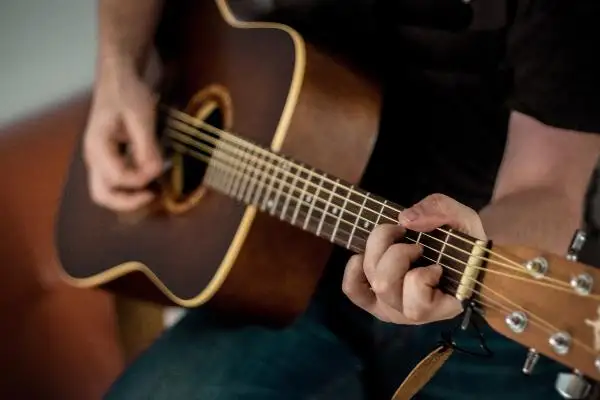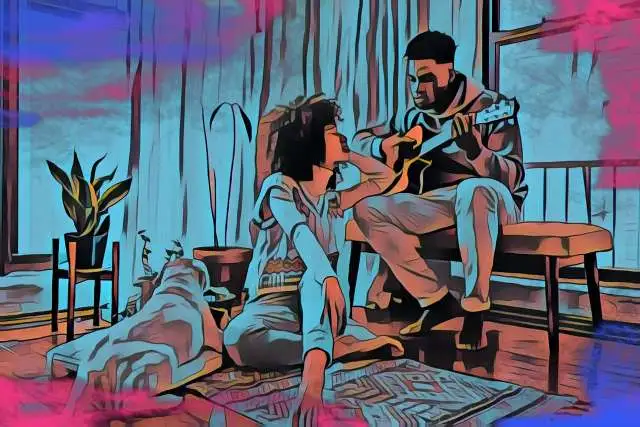Do you want to learn how to write a love song but don't know where to start? Writing songs of any kind can be intimidating, but love songs are particularly challenging since they are so personal by nature.
We've put together a comprehensive guide that will make the process of writing a love song a breeze for you. With these 9 simple steps, you'll be able to craft a whole song from start to finish, so let's get the ball rolling!
1. Adopt A Musician's Mindset
Sometimes, the most difficult part about writing songs is getting into the right mindset as a musician. In order to begin writing, you have to get past the challenging reality that songwriting is incredibly vulnerable. You'll often write lyrics that are incredibly real to you in your personal and private life. It can feel like everyone is going to pick you apart when you release music publicly.
However, this couldn't be further from the truth. Remember, songwriting is an art form that is fully open to orientation. Most of the time, when we listen to music, we're thinking about ourselves and how we can apply lyrics to our own personal situations.
This is what makes music so inherently powerful. Most love songs are able to connect with listeners on an incredibly deep level, all due to a couple of bars of music and vulnerable song lyrics.
While you're writing love songs, remember that it ultimately serves a greater purpose. Being vulnerable is incredibly cathartic and ultimately helps listeners resonate on a deeper level. The most popular love songs are based on personal experiences because real music connects with real people. It can be scary to put yourself out there, but try your best to push through insecurity and let your thoughts roam free.

2. Choose Your Love Song Type
Once you're ready to get started, you'll need to select the type of love song you're interested in writing. There is a myriad of love song types that fall in and outside these general categories, but here are a couple of ideas to get you started:
A Request
Is there something you wish your lover would realize or own up to? Do you have a request or plea to improve your relationship? Some great love songs come in the form of requests. Whether your relationship has just begun or it's on its last stand, this prompt is sure to conjure up some ideas.
Admiration
This one is pretty self-explanatory, but there are a bunch of ways to write a love song admiring your partner or crush. You can even write about admiring a place or platonic relationship. Love songs don't necessarily need to be about lovers to strike a chord in the listener.
Breakup
There are plenty of breakup songs on the Billboard charts, not without good reason. After all, there are few experiences that are so heart-wrenching and universal. Breakup songs aren't just powerful for listeners; they can help you take a painful experience and turn it into a positive one.
Jealousy
Jealousy is a human feeling that everyone experiences but are afraid to discuss. Luckily, music presents us with an opportunity to express ourselves in a productive way. Instead of acting about jealousy, you can turn it into a love song.
Writing songs about the one that got away or someone who you wish you dated but never got the chance to is a great place to start. For additional ideas, check out our article with over 200 song prompts .
Unrequited Love
Writing lyrics about a crush is incredibly natural. After all, it's a lot easier to learn how to write a love song than it is to face the terrifying possibility of rejection. Write love songs about wanting an impossible relationship or how it feels to have strong feelings for someone who doesn't feel the same. You could also write about a common relationship mismatch like dating the right person at the wrong time.
Comfort
If you're one of the lucky people in a happy relationship, you can write about that too! A basic love song can cover what you've gone through as a couple, how much your relationship means to you, and how your relationship has helped you grow as an individual.
Check out Al Green's "Let's Stay Together" for a soulful example of this track type:
Note that these love song prompts are just ideas! Feel free to tinker and tweak according to your experience. Remember that love songs can be about just anything and anyone, not just your romantic partner.

3. Sort Out Your Feelings
Now that you have a general idea of what direction you want to take, try to sort out your feelings and get them out on paper. During this stage, allow yourself to have a brainstorm that's as free-flowing and unedited as possible. Don't worry! You'll have plenty of time to make those final touches later on in the process.
It may be helpful to write down details from your personal experience that could turn into lyric ideas in your song. Write down the main idea of your love song and anything else that comes to mind. You might even see song titles emerge. Follow your instincts to a core.
After you get the basic idea of what you want your love song to portray, think about all the qualities you want to build into your mix. Will your song be more upbeat (usually in a major key) or be a bit more somber (typically in a minor key)? Will the tempo be fast or slow? Does a specific vocal pattern come to mind?
It may be helpful to keep your voice memos app or recording software open to record any spontaneous ideas. The goal of this step is to create a clear vision of what you want your love song to sound and feel like.
4. Listen To Some References
If you're having trouble finding your footing or simply want a great example of two of excellent love songs, seek them out! There's nothing wrong with learning from references, and this step can be incredibly pivotal when you're writing your first batch of love songs.
Granted, it's never okay to plagiarize. You can't have the same vocal pattern, melody, or lift lyrics from your favorite track. However, you can certainly learn from how a particular artist built their vocal melody or cultivated a song's structure.
Take note of how long it takes the performer to move from verse to chorus. Study how a singer can incorporate heartfelt emotion into their vocal phrasing and lyrics. It might be a good idea to pick out one great love song that meets all of the expectations you set in the previous step of the process.

5. Find Your Starting Point
Now that you have a clear vision and some popular songs for reference, you have everything you need to write a love song. From here on out, your process is malleable and should be catered to what makes you feel the most comfortable as a musician. We'll share some of the most common starting points you can build off of when writing love songs, but remember that you can use any of them or none at all.
Love songs follow a similar formula, but there are many different paths to ending up in the same place.
Chords
Finding a great chord progression is a quick and easy way to jumpstart your creative process. Chord progressions can easily be looped and can help get you inspired while you're focused on crafting lyrics for a loved one. Many musicians are able to intuitively figure out what notes fit within a chord progression's key just by taking a listen, but if that doesn't work for you, just look it up!
You can always write a melody over your chord progression using your preferred instrument. As long as your notes are in key, they are bound to sound good! Just keep in mind that the strongest notes are often the tonic, dominant, and subdominant, or the 1st, 4th, and 5th notes in any given scale.
Lyrics
When it comes to something as personal as a love song, it often makes sense to start with the lyrics. Take a look at your brainstorm page and see if you can pair certain ideas together. Start to edit your words so that your lines have roughly the same cadence to them and hold a rhyme scheme.
Written lyrics can feel different when they aren't said aloud, so practice speaking different rhythms with the same line. You'll find that there are plenty of ways to say the same set of words, which is what makes writing so exciting! If you're really getting into it, turning on a metronome or a click track can help your iron out the rhythm of your lyrics before you put a melody to them.
Beat
Since feelings carry through rhythm and expression, you can definitely build up a love song starting from a beat. You can make beats in your DAW and loop them while writing to the rhythm. Loops are another great resource that can get you singing even if you don't produce. Feel free to play on top of what you created by incorporating additional instruments or building in a different pattern.

6. Build Upon Your Foundation
Congratulations! The love song creation process only gets easier from here on. Now that you have a basic song idea, it's now time to put on your editing hat and remove anything that isn't needed or add sonic details that will take your creation a step further. Here are a couple of factors you may want to consider:
Rhyme Scheme
Incorporating a similar pattern of rhyme throughout your song can help listeners latch onto your melody, lyrics, and writing. A strong rhyme scheme makes things catchy and oftentimes more appealing, so make sure your lyrics incorporate obvious and internal rhyme.
Sometimes, you'll have to reword your lyrics or switch up your phrasing, but trust us, it's worth the hassle. Most of your favorite songs probably have a strong rhyme scheme and learning how to use rhyme strategically is a clear mark of a skilled songwriter.
Melodies
The beautiful thing about music writing is that there are so many ways to depict one feeling. You might write a melody line and stumble upon a stronger one later, and that's okay. Really take a listen to the melodies throughout your song and make sure the sound is serving the message of your creation. Your melodies should easily flow from one section to the next and hold a catchy pattern that is destined to get stuck in your head.
Rhythm
Rhythm is incredibly powerful and can affect how certain lines and lyrics are perceived in your song. Take time to listen to the pacing of your lyrics, and adjust if anything feels off or imbalanced. It might even be helpful to speak the words aloud to catch any overlooked overstuffing. Consider the rhythm of the beat, too. Do the rhythmic changes in the song make sense in context with the emotional and lyrical movement? Does the groove match the feeling of the song? Adjust where needed.
A Punchline
A good love song might have a particular line that stands out against the rest, making for a more impactful composition. These lines are often incorporated towards the end of the chorus and might even be incorporated within the title of a piece of work. For instance, Bruno Mars' song "When I was your man" only reveals that his relationship cannot be salvaged with the gutting punchline at the end of the chorus:
7. Make Edits As Needed
After you've crafted your first draft of the song, take a step back. It's a good idea to tackle it the following day and rest on your track since your ear fatigue can cloud your perspective. Don't be afraid to make multiple versions of the same song-- Just set up a separate session so that you don't lose your previous progress.
Songwriting is mysterious in that some songs flow out within a matter of minutes while others go through countless versions and revisions before making their way to a formal release. Try not to be discouraged if your experience is the latter -- Even the strongest songwriter has to work through tedious moments like these ones.
8. Record Your Song
If your song is set in its melodies, chord progression, lyrics, and rhythm, it's time to formally record it! We have a whole guide on how to record a song , but you can essentially hire a producer to walk you through the process or do it on your own with the help of a DAW .
You might find that while recording, you have different feelings about certain sections or want to add extra notes. This is totally natural. You might end up rewriting the song entirely but trust your instincts. Sometimes, performing your song in a live setting is enough to give you some perspective that was otherwise missing.
9. Get Feedback
You did it! Give yourself a pat on the back because writing a love song is no easy feat, especially if you haven't done it in the past, but don't stop there. Take your song to other musicians and trusted friends for feedback.
Granted, feedback on art is super subjective, but if you find that there's a common thread between comments on your song, it may be something to rework in your next version of the track or incorporate into your process moving forward.
It's also a good idea to get feedback by playing live or even going so far to sing to your loved one mentioned in the song. When all else fails, write another love song! Cultivating amazing songwriting takes practice, and you'll only get better with each passing creation.
Writing love songs can be intimidating, but it doesn't have to be. Hopefully, this guide made it easier for you to write your first love song from start to finish. Enjoy the songwriting process!





